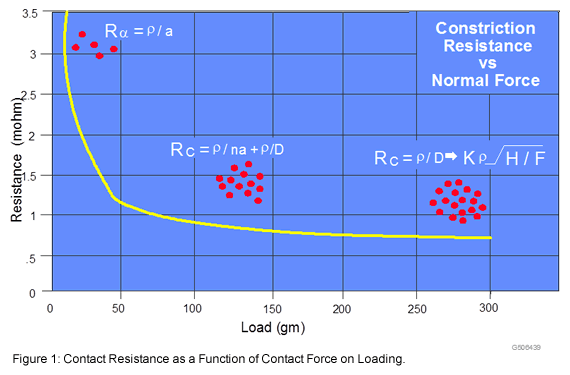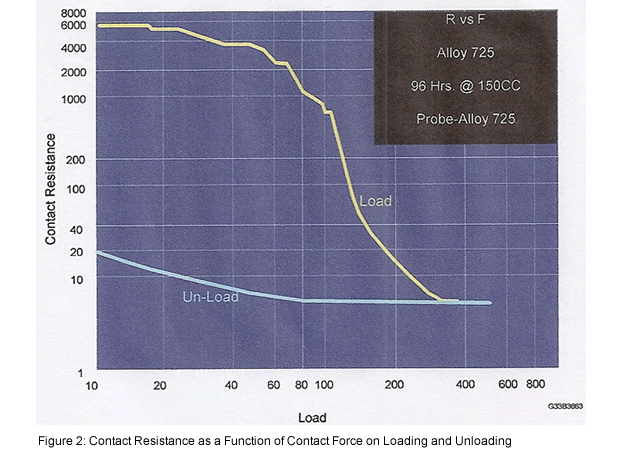Stress Relaxation II – Effects on Performance
Stress Relaxation II
Effects on Performance
The February feature, Stress Relaxation I: Mechanisms, Materials and Temperature, described the mechanism of stress relaxation as repositioning of atoms to reduce localized stresses and the resulting loss in contact force, and reduction in mechanical stability. Now, let’s see how that repositioning and force reduction can affect connector performance — in particular, the magnitude and stability of the resistance of the contact interface. Consider first the reduction in contact force.
The initial effect of loss in contact force is negligible. Recall that one of the functions of contact force is to create the contact interface by deformation of the mating surfaces against one another to produce a distribution of small contact areas — a-spots — that determine the contact interface resistance. This a-spot distribution is created on mating, which occurs at the original design contact force.
Figure 1 schematically illustrates the creation of the multi-spot contact interface as the contact normal force increases. The number of a-spots and the contact area over which they are distributed increases with the force applied.  Reduction in contact force due to stress relaxation will not result in a reduction of the original contact area, and therefore, will not result in an increase in contact resistance, as illustrated in Figure 2. Note that the contact resistance remains constant as the contact force decreases from 300 grams to less than 100 grams. Beyond this reduction, the beam begins to unload so the contact area decreases and the contact resistance increases.
Reduction in contact force due to stress relaxation will not result in a reduction of the original contact area, and therefore, will not result in an increase in contact resistance, as illustrated in Figure 2. Note that the contact resistance remains constant as the contact force decreases from 300 grams to less than 100 grams. Beyond this reduction, the beam begins to unload so the contact area decreases and the contact resistance increases.
 (For completeness, a few comments on Figure 2 are appropriate. The difference between Figure 1 and Figure 2 at low contact forces is due to the difference in materials. Figure 1 relates to gold/nickel-finished contacts, while Figure 2 data is from a CA72500 (copper88.2-nickel9.5-tin2.3) alloy contact system aged in air for 96 hours at 150 degrees centigrade. This aging process creates surface oxide films, which must be displaced before the desired metal-to-metal contact interfaces can be realized. Thus, the high resistance region prior to oxide breakthrough and displacement and the rapid decrease in contact resistance after breakthrough.)
(For completeness, a few comments on Figure 2 are appropriate. The difference between Figure 1 and Figure 2 at low contact forces is due to the difference in materials. Figure 1 relates to gold/nickel-finished contacts, while Figure 2 data is from a CA72500 (copper88.2-nickel9.5-tin2.3) alloy contact system aged in air for 96 hours at 150 degrees centigrade. This aging process creates surface oxide films, which must be displaced before the desired metal-to-metal contact interfaces can be realized. Thus, the high resistance region prior to oxide breakthrough and displacement and the rapid decrease in contact resistance after breakthrough.)
Changes in resistance only occur when the contact interface is disturbed by application-related driving forces, as a result of the reduction in mechanical stability. The disturbed contact interface area will be created at the reduced contact force and can be expected to have a slightly higher contact resistance. However, more significant increases in contact resistance can occur if there are contaminants, particulates, or corrosion products in or around the contact interface. The motion of the contact interface can incorporate such contaminants into the new contact interface, resulting in resistance increases.
The most important effect of loss in contact force due to stress relaxation is the reduction in mechanical stability.
The effects of the atomic rearrangement are more subtle. The deflected position of the contact beam as the connector is mated determines the stress distribution in the beam. The driving force for atomic rearrangement is to lower the stress in the beam while mated, which reduces the elastic spring-back of the beams when the connector is unmated, causing a thermally driven permanent change in the beam configuration. The end result is effectively the same as that which occurs if a contact beam is overstressed into the plastic range by an oversized plug contact or plug misalignment on mating, a permanent reduction in the contact force of the system.
Consider a twin beam contact system in which the gap between the two beams determines the beam deflections, and therefore, the contact force on mating. The atomic rearrangement results in a reduced spring-back, and therefore, an increase in the gap between the two beams when the connector is unmated. This means that on all subsequent matings, the contact force will be lower than the original design value. The effect of the force reduction on the initial contact interface resistance will most likely be minimal, but, again, the mechanical stability of the interface will be compromised, increasing the potential for degradation of the contact interface over time.
The effect of the atomic rearrangements that occur during stress relaxation is a change of the contact beam configuration, which causes a reduction in the contact force of the system while mated and a permanent reduction in the contact force on subsequent matings.
Given this explanation of the potential effects of stress relaxation on connector performance, what can we do to eliminate or moderate these effects?
A design option is to increase the design contact force to the point that the reduction of contact force due to stress relaxation does not result in an unacceptable reduction in mechanical stability. The benefits of an increase in contact force, however, must be balanced against negative effects of increased contact mating force and increased wear, both mating and fretting wear.
A materials approach is to use a contact spring material that has adequate stress relaxation resistance at the intended application temperature. Stress relaxation performance is very predictable, and data for a variety of alloys is available from material suppliers. As discussed, stress relaxation is a diffusion-controlled process, and therefore, is strongly dependent on temperature. A rule of thumb is that the reaction rates of diffusion-controlled processes doubles for every 10 degree centigrade increase in temperature. It is good practice to consider stress relaxation issues for application temperatures above, say, 65 degrees centigrade. As noted in the previous article, second-phase-strengthened alloys provide improved stress relaxation performance compared to work-hardened alloys.
- Nanocrystalline Silver Alloy Contact Finishes in Electronic Applications - April 6, 2015
- Nanocrystalline Silver Contact Platings - March 16, 2015
- Dr. Bob on Gold Flash Contact Finishes (and Max Peel) - September 22, 2014






